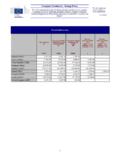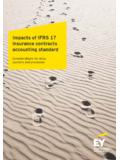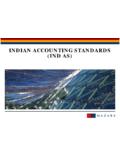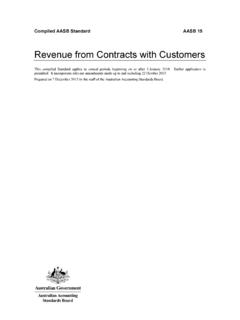Transcription of International Financial Reporting Standard 3 …
1 EC staff consolidated version as of 18 February 2011. FOR INFORMATION PURPOSES ONLY. International Financial Reporting Standard 3. Business Combinations Objective 1 The objective of this IFRS is to improve the relevance, reliability and comparability of the information that a Reporting entity provides in its Financial statements about a business combination and its effects. To accomplish that, this IFRS establishes principles and requirements for how the acquirer: (a) recognises and measures in its Financial statements the identifiable assets acquired, the liabilities assumed and any non-controlling interest in the acquiree;. (b) recognises and measures the goodwill acquired in the business combination or a gain from a bargain purchase; and (c) determines what information to disclose to enable users of the Financial statements to evaluate the nature and Financial effects of the business combination.
2 Scope 2 This IFRS applies to a transaction or other event that meets the definition of a business combination. This IFRS does not apply to: (a) the formation of a joint venture. (b) the acquisition of an asset or a group of assets that does not constitute a business. In such cases the acquirer shall identify and recognise the individual identifiable assets acquired (including those assets that meet the definition of, and recognition criteria for, intangible assets in IAS 38. Intangible Assets) and liabilities assumed. The cost of the group shall be allocated to the individual identifiable assets and liabilities on the basis of their relative fair values at the date of purchase. Such a transaction or event does not give rise to goodwill. (c) a combination of entities or businesses under common control (paragraphs B1 B4 provide related application guidance).
3 Identifying a business combination 3 An entity shall determine whether a transaction or other event is a business combination by applying the definition in this IFRS, which requires that the assets acquired and liabilities assumed constitute a business. If the assets acquired are not a business, the Reporting entity shall account for the transaction or other event as an asset acquisition. Paragraphs B5 B12 provide guidance on identifying a business combination and the definition of a business. The acquisition method 4 An entity shall account for each business combination by applying the acquisition method. 5 Applying the acquisition method requires: (a) identifying the acquirer;. (b) determining the acquisition date;. 1. EC staff consolidated version as of 18 February 2011.
4 FOR INFORMATION PURPOSES ONLY. (c) recognising and measuring the identifiable assets acquired, the liabilities assumed and any non- controlling interest in the acquiree; and (d) recognising and measuring goodwill or a gain from a bargain purchase. Identifying the acquirer 6 For each business combination, one of the combining entities shall be identified as the acquirer. 7 The guidance in IAS 27 Consolidated and Separate Financial Statements shall be used to identify the acquirer the entity that obtains control of the acquiree. If a business combination has occurred but applying the guidance in IAS 27 does not clearly indicate which of the combining entities is the acquirer, the factors in paragraphs B14 B18 shall be considered in making that determination. Determining the acquisition date 8 The acquirer shall identify the acquisition date, which is the date on which it obtains control of the acquiree.
5 9 The date on which the acquirer obtains control of the acquiree is generally the date on which the acquirer legally transfers the consideration, acquires the assets and assumes the liabilities of the acquiree the closing date. However, the acquirer might obtain control on a date that is either earlier or later than the closing date. For example, the acquisition date precedes the closing date if a written agreement provides that the acquirer obtains control of the acquiree on a date before the closing date. An acquirer shall consider all pertinent facts and circumstances in identifying the acquisition date. Recognising and measuring the identifiable assets acquired, the liabilities assumed and any non-controlling interest in the acquiree Recognition principle 10 As of the acquisition date, the acquirer shall recognise, separately from goodwill, the identifiable assets acquired, the liabilities assumed and any non-controlling interest in the acquiree.
6 Recognition of identifiable assets acquired and liabilities assumed is subject to the conditions specified in paragraphs 11 and 12. Recognition conditions 11 To qualify for recognition as part of applying the acquisition method, the identifiable assets acquired and liabilities assumed must meet the definitions of assets and liabilities in the Framework for the Preparation and Presentation of Financial Statements at the acquisition date. For example, costs the acquirer expects but is not obliged to incur in the future to effect its plan to exit an activity of an acquiree or to terminate the employment of or relocate an acquiree's employees are not liabilities at the acquisition date. Therefore, the acquirer does not recognise those costs as part of applying the acquisition method.
7 Instead, the acquirer recognises those costs in its post-combination Financial statements in accordance with other IFRSs. 12 In addition, to qualify for recognition as part of applying the acquisition method, the identifiable assets acquired and liabilities assumed must be part of what the acquirer and the acquiree (or its former owners). exchanged in the business combination transaction rather than the result of separate transactions. The acquirer shall apply the guidance in paragraphs 51 53 to determine which assets acquired or liabilities assumed are part of the exchange for the acquiree and which, if any, are the result of separate transactions to be accounted for in accordance with their nature and the applicable IFRSs. 13 The acquirer's application of the recognition principle and conditions may result in recognising some assets and liabilities that the acquiree had not previously recognised as assets and liabilities in its Financial statements.
8 For example, the acquirer recognises the acquired identifiable intangible assets, such as a brand 2. EC staff consolidated version as of 18 February 2011. FOR INFORMATION PURPOSES ONLY. name, a patent or a customer relationship, that the acquiree did not recognise as assets in its Financial statements because it developed them internally and charged the related costs to expense. 14 Paragraphs B28 B40 provide guidance on recognising operating leases and intangible assets. Paragraphs 22 28 specify the types of identifiable assets and liabilities that include items for which this IFRS provides limited exceptions to the recognition principle and conditions. Classifying or designating identifiable assets acquired and liabilities assumed in a business combination 15 At the acquisition date, the acquirer shall classify or designate the identifiable assets acquired and liabilities assumed as necessary to apply other IFRSs subsequently.
9 The acquirer shall make those classifications or designations on the basis of the contractual terms, economic conditions, its operating or accounting policies and other pertinent conditions as they exist at the acquisition date. 16 In some situations, IFRSs provide for different accounting depending on how an entity classifies or designates a particular asset or liability. Examples of classifications or designations that the acquirer shall make on the basis of the pertinent conditions as they exist at the acquisition date include but are not limited to: (a) classification of particular Financial assets and liabilities as a Financial asset or liability at fair value through profit or loss, or as a Financial asset available for sale or held to maturity, in accordance with IAS 39 Financial Instruments: Recognition and Measurement.
10 (b) designation of a derivative instrument as a hedging instrument in accordance with IAS 39; and (c) assessment of whether an embedded derivative should be separated from the host contract in accordance with IAS 39 (which is a matter of classification' as this IFRS uses that term). 17 This IFRS provides two exceptions to the principle in paragraph 15: (a) classification of a lease contract as either an operating lease or a finance lease in accordance with IAS 17 Leases; and (b) classification of a contract as an insurance contract in accordance with IFRS 4 Insurance Contracts. The acquirer shall classify those contracts on the basis of the contractual terms and other factors at the inception of the contract (or, if the terms of the contract have been modified in a manner that would change its classification, at the date of that modification, which might be the acquisition date).














